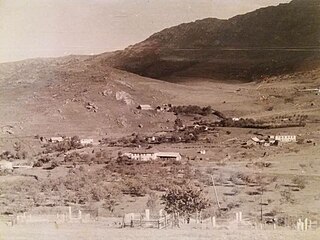Bozlu | |
|---|---|
| Coordinates: 39°41′44″N46°19′50″E / 39.69556°N 46.33056°E | |
| Country | |
| District | Lachin |
| Population (2015) [1] | |
| • Total | 211 |
| Time zone | UTC+4 (AZT) |

Bozlu is a village in the Lachin District of Azerbaijan.
Bozlu | |
|---|---|
| Coordinates: 39°41′44″N46°19′50″E / 39.69556°N 46.33056°E | |
| Country | |
| District | Lachin |
| Population (2015) [1] | |
| • Total | 211 |
| Time zone | UTC+4 (AZT) |

Bozlu is a village in the Lachin District of Azerbaijan.
The village was located in the Armenian-occupied territories surrounding Nagorno-Karabakh, coming under the control of ethnic Armenian forces during the First Nagorno-Karabakh War in the early 1990s. The village subsequently became part of the breakaway Republic of Artsakh as part of its Kashatagh Province, referred to as Moshatagh (Armenian : Մոշաթաղ). It was returned to Azerbaijan as part of the 2020 Nagorno-Karabakh ceasefire agreement.

Lachin is a town in Azerbaijan and the administrative centre of the Lachin District. It is located within the strategic Lachin corridor, which linked the region of Nagorno-Karabakh with Armenia.

Qoşasu is a village in the Lachin District of Azerbaijan.
Malkhalaf or Maratuk is a village in the Lachin District of Azerbaijan. Prior to October 2023, the village was located in the new corridor between Armenia and Nagorno-Karabakh, controlled by Russian peacekeepers, that replaced the Lachin corridor in August 2022.
Malikpaya or Melikahogh is a village in the Lachin District of Azerbaijan. Prior to October 2023, the village was located in the new corridor between Armenia and Nagorno-Karabakh, controlled by Russian peacekeepers, that replaced the Lachin corridor in August 2022.
Mighidara or Meghvadzor is a village in the Lachin District of Azerbaijan. Prior to October 2023, the village was located in the new corridor between Armenia and Nagorno-Karabakh, controlled by Russian peacekeepers, that replaced the Lachin corridor in August 2022.

Zabukh or Aghavno is a village in the Lachin District of Azerbaijan. The village came under the control of the breakaway Republic of Artsakh after 1992 and was renamed Aghavno and settled by Armenians. Following the 2020 Nagorno-Karabakh war, Zabukh came under the control of the Russian peacekeeping forces in Nagorno-Karabakh. On 26 August 2022, Azerbaijan regained control of Zabukh along with other settlements located along the former route of the Lachin corridor, including Lachin and Sus.
Unannovu or Hunanav is a village in the Lachin District of Azerbaijan. Prior to a 2023 offensive by Azerbaijan, the village was located in a new corridor between Armenia and Nagorno-Karabakh, controlled by Russian peacekeepers, that replaced the Lachin corridor in August 2022.
Aghanus is a village in the Lachin District of Azerbaijan.

Köhnəkənd is a village in the Lachin District of Azerbaijan.
Ağcakənd is a village in the Lachin District of Azerbaijan.
Ağcayazı is a village in the Lachin District of Azerbaijan.

Qorçu is a village in the Lachin District of Azerbaijan. The village is 64 kilometres away from Lachin, and is 1,884 meters above sea level. It is located near a large forested area.

Mirik is a village in the Lachin District of Azerbaijan.
Seyidlər is a village in the Lachin District of Azerbaijan.
Səfiyan is a village in the Lachin District of Azerbaijan.

Lachin District is one of the 66 districts of Azerbaijan. It is located in the west of the country, belonging to the East Zangezur Economic Region. The district borders the districts of Kalbajar, Khojaly, Shusha, Khojavend, Qubadli, and the Syunik Province of Armenia. Its capital and largest city is Lachin. As of 2020, the district had a nominal population of 78,600.

The Lachin corridor was a mountain road in Azerbaijan that linked Armenia and Karabakh.

The Kurds in Azerbaijan form a part of the historically significant Kurdish population in the post-Soviet space. Kurds established a presence in the Caucasus with the establishment of the Kurdish Shaddadid dynasty in the 10th and 11th centuries. Some Kurdish tribes were recorded in Karabakh by the end of the sixteenth century. However, virtually the entire contemporary Kurdish population in the modern Azerbaijan descends from migrants from 19th-century Qajar Iran.
Kamil Nasibov was a soldier in the First Nagorno-Karabakh War and officially claimed National Hero of Azerbaijan. He was of Kurdish descent.
Gorkhmaz Abysh oglu Eyvazov was an Azerbaijani policeman, foreman of the Internal Troops of the Ministry of Internal Affairs of Azerbaijan, participant of the First Nagorno-Karabakh War, National Hero of Azerbaijan.